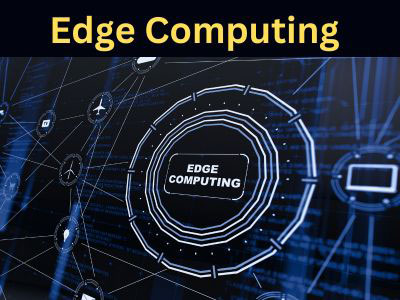Key Takeaway
The future booming technology in the IT industry is edge computing combined with AI. These technologies will enable faster decision-making and real-time applications across industries. With the rise of IoT devices and 5G networks, edge computing will play a critical role in handling decentralized data efficiently.
Other key technologies include quantum computing for solving complex problems, blockchain for secure transactions, and advancements in cybersecurity. Cloud-edge integration will also drive innovation, making IT systems faster, smarter, and more secure.
Edge Computing as a Game-Changer in IT
Edge computing is rapidly becoming a game-changer in the IT landscape, offering new capabilities that are transforming industries and revolutionizing how businesses manage and process data. By processing data closer to where it is generated, edge computing addresses key challenges faced by traditional cloud computing, including latency, bandwidth limitations, and data security.
One of the primary advantages of edge computing is real-time data processing. In sectors such as healthcare, manufacturing, and autonomous vehicles, decisions need to be made quickly to ensure safety and efficiency. Edge computing enables these decisions to be made instantly, without the delay of sending data to a centralized cloud server. This is especially important for applications like predictive maintenance, where machinery can alert operators about potential issues before they cause major disruptions.
Another benefit is the reduction of bandwidth usage. By processing data locally, only relevant and summarized data needs to be sent to the cloud, reducing network congestion and bandwidth costs. This is particularly valuable in industries like agriculture, where remote locations may not have reliable internet access. Edge computing allows devices to continue functioning even in low or no connectivity environments.
In addition to these practical benefits, edge computing also enhances data security. By keeping sensitive data local and processing it at the edge, businesses can reduce the risk of data breaches that can occur when transmitting large amounts of sensitive information to a central server. This makes edge computing particularly useful in industries with stringent security requirements, such as finance, healthcare, and government.

AI-Powered Edge Devices for IT Solutions
The rise of AI-powered edge devices is revolutionizing how businesses approach IT solutions. These devices combine the power of edge computing with artificial intelligence, enabling local data processing and real-time decision-making. By integrating AI into edge devices, companies can significantly enhance their operations, reduce latency, and increase efficiency.
In the manufacturing sector, AI-powered edge devices can monitor and analyze machine data in real-time, predicting equipment failures and scheduling maintenance before issues arise. This predictive maintenance is crucial for minimizing downtime and ensuring that production processes run smoothly.
In healthcare, AI-powered edge devices can provide real-time health monitoring, offering insights into a patient’s condition based on data from wearable devices or medical sensors. This enables doctors and healthcare providers to make immediate decisions, improving patient care and treatment outcomes.
In smart cities, AI-driven edge devices can help manage traffic flow, optimize energy consumption, and improve public safety. For example, AI algorithms can analyze data from surveillance cameras, sensors, and traffic lights to predict and prevent accidents, improve traffic patterns, and enhance emergency response times.
You May Like to Read
Cybersecurity Advancements Through Edge Computing
As cyber threats become increasingly sophisticated, traditional centralized security systems often fall short in addressing vulnerabilities. This is where edge computing offers a significant advantage. By processing data closer to where it is generated, edge computing allows businesses to implement security protocols at each edge device, reducing the risk of data breaches. In addition, edge computing minimizes the volume of sensitive data being transmitted to centralized servers, making it harder for attackers to intercept. In the future, edge-based security solutions will become essential in safeguarding the integrity of business operations, particularly in industries dealing with highly sensitive information.
The Role of Edge in IT Infrastructure Optimization
The optimization of IT infrastructure is crucial as businesses look to become more agile, responsive, and efficient. Edge computing plays a key role in this by offloading tasks from centralized data centers and reducing the dependency on cloud services. By bringing computation closer to the data source, edge devices can process information locally, enabling faster decision-making and reducing the strain on network bandwidth. In industries such as finance, healthcare, and manufacturing, this means better performance, quicker responses, and more reliable systems. Over the next decade, edge computing will continue to be a key factor in optimizing IT infrastructures, enabling organizations to remain competitive in an increasingly digital world.
5G Edge Integration in IT Operations
The arrival of 5G networks is set to further enhance the capabilities of edge computing. With its ultra-low latency and high-speed data transmission, 5G networks will provide the perfect environment for edge devices to operate at their full potential. The integration of 5G with edge computing will enable more efficient IT operations across various sectors, such as autonomous vehicles, remote healthcare, and smart cities. This combination will facilitate real-time communication, faster data processing, and seamless connectivity. As 5G networks continue to roll out globally, we can expect a surge in edge computing adoption, with businesses leveraging the power of both technologies to enhance their operations and services.
Conclusion
The IT industry is standing on the precipice of a revolution, and edge computing is leading the charge. As businesses continue to grapple with the explosion of data and the need for faster, more efficient operations, edge computing provides a solution that promises to address these challenges. With the integration of AI, cybersecurity advancements, and the rollout of 5G networks, the potential for edge computing in IT is limitless. In the coming years, edge computing will be a central component of IT strategies across industries, enabling businesses to harness the full power of their data and stay competitive in an increasingly digital world.
